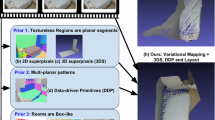Abstract
The recovery of the 3D structure of indoor scenes from a single image is an important goal of machine vision Therefore, a simple and reliable solution to this problem will have a great influence on many tasks in robotics, such as the autonomous navigation of a mobile vehicle in indoor environments.
This communication describes the recovery, in a reliable and robust way, of the 3D structure of a corridor and of obstacles from a sequence of images obtained by a T.V. camera moving through the corridor. The obtained 3D information can be used to extract the free space in the viewed scene in order to plan the trajectory of a mobile vehicle. This application is being worked on at the moment and the results will be illustrated in a future communication.
Chapter PDF
Similar content being viewed by others
Keywords
These keywords were added by machine and not by the authors. This process is experimental and the keywords may be updated as the learning algorithm improves.
References
Barrow, H.G, Tenenbaum, J.M.: Interpreting line-drawings as three-dimensional surfaces. Artif. Intell. 17 (1981) 75–116
Coelho C., Straforini M., Campani M.: A fast and precise method to extract vanishing points, SPIE's International Symposia on Applications in Optical Science and Engineering, Boston 1990.
Haralick, R.M.: Using perspective transformation in scene analysis. Comput. Graphics Image Process 13 (1980) 191–221
Straforini, M., Coelho, C., Campani, M., Torre V.: The recovery and understanding of a line drawing from indoor scenes. PAMI in the press (1991)
Author information
Authors and Affiliations
Editor information
Rights and permissions
Copyright information
© 1992 Springer-Verlag Berlin Heidelberg
About this paper
Cite this paper
Olivieri, P., Gatti, M., Straforini, M., Torre, V. (1992). A method for the 3D reconstruction of indoor scenes from monocular images. In: Sandini, G. (eds) Computer Vision — ECCV'92. ECCV 1992. Lecture Notes in Computer Science, vol 588. Springer, Berlin, Heidelberg. https://doi.org/10.1007/3-540-55426-2_76
Download citation
DOI: https://doi.org/10.1007/3-540-55426-2_76
Published:
Publisher Name: Springer, Berlin, Heidelberg
Print ISBN: 978-3-540-55426-4
Online ISBN: 978-3-540-47069-4
eBook Packages: Springer Book Archive




